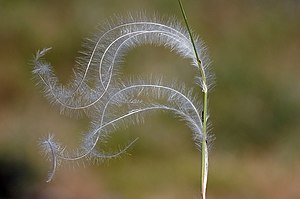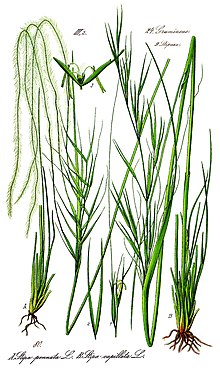Real feather grass
| Real feather grass | ||||||||||||
|---|---|---|---|---|---|---|---|---|---|---|---|---|

Real feather grass ( Stipa pennata ) |
||||||||||||
| Systematics | ||||||||||||
|
||||||||||||
| Scientific name | ||||||||||||
| Stipa pennata | ||||||||||||
| L. |
The real feather grass ( Stipa pennata ), gray silk feather grass or the whiskered beard is a plant species within the sweet grass family (Poaceae). It forms 40 to 70 centimeter high stalks and up to 33 centimeters long, densely covered with long hair awns .
description

Appearance and leaves
The real feather grass is a perennial herbaceous plant that forms dense clumps . The stalks are upright, have two to four knots , are 40 to 70 centimeters high and are rough under the panicle . The leaf sheaths are hairless or hairy more or less densely about 0.1 millimeters long. The edges in the upper part of the leaf sheath are sometimes ciliate. The ligules of the renewal shoot form a 1 to 2 millimeter long, membranous border, the ligules of the stalk leaves are 3 to 5 millimeters long. The thread-like leaf blades are blue-green and reach lengths of up to 50 centimeters and diameters of 0.5 to 1 millimeter. At least at the tip of young leaves there is a clump of up to 3 millimeters long, protruding hair. The underside of the spread is usually bald and smooth, but sometimes rough or hairy in the lower part.
Inflorescence, flowers and fruits
The inflorescences are composed of five to nine spikelets , contracted, about 10 centimeters long, elliptical panicles that stick at the base in the uppermost leaf sheath. The spikelets are single-flowered, lanceolate and without awn usually 30 to 50 and rarely up to 70 millimeters long. The glumes are equal to each other, permanent, yellow, five- to seven-veined and as long as the spikelets. The florets , together with the 3 millimeter long and densely hairy callus, are 15 to 18 millimeters long and about 1.4 millimeters wide. The tip of the callus is curved like a claw, piercing and glabrous. The lemma is five-nerved, 15 to 20 millimeters long, almost terete and shows seven rows of short hairs. The rows of hairs on the edge end (3 to) 4 to 5 millimeters below the point of attachment of the awn. The middle row protrudes over the neighboring ones by about 2 millimeters. The awn is 25 to 33 centimeters long, the upper part is densely covered with 5 to 6 millimeter long hairs. The palea is linear, two-veined and as long as the lemma. The anthers are 5 to 6.5 millimeters long. 12 to 15 millimeters long, spindle-shaped caryopses are formed as fruits. The flowering time is in May and June.
Chromosome number
The number of chromosomes is 2n = 44.
Distribution and ecology
The natural range of the feather grass extends from Central, Northern, Southern and Eastern Europe to North Africa, and in Asia to Siberia, the Caucasus, Pakistan, Mongolia and China.
It occurs in patchy steppe lawns, on rocky slopes and in sparse forests on summer-dry, warm, base-rich, often calcareous, shallow, nutrient-poor, stony or, more rarely, sandy soils. It is a light plant and a heat pointer. It is a character species of the Festucion valesiacae association.
The real feathergrass is a hemicryptophyte . The fruits are spread by the wind and when water is absorbed they drill themselves into the ground through a rotating movement of the awn.
Systematics and research history
The real feather grass ( Stipa pennata ) is a species from the genus of feather grasses ( Stipa ) in the family of sweet grasses (Poaceae), in which it is assigned to the subfamily Pooideae , tribe Stipeae . The species was first scientifically described by Carl von Linné in 1753 in Species Plantarum . The genus name Stipa was introduced by Linnaeus without representatives of the genus having been previously referred to with this name. The late Latin word stipa was used to designate a rod for supporting amphorae. The specific epithet pennata also comes from Latin and means "feathered". It thus refers to the long-haired awns of the species.
Synonyms of the species include Stipa anomala P.A. Smirn. , Stipa appendiculata Celak. , Stipa austriaca (Beck) Klokov , Stipa borysthenica Prokudin , Stipa disjuncta Klokov , Stipa gallica (Steven) Celak. , Stipa joannis Čelak. , Stipa lejophylla P.A. Smirn . , Stipa oligotricha Moraldo , Stipa sabulosa (Pacz.) Sljuss. , Stipa tauricola Celak. and Stipa veneta Moraldo .
According to Floraweb, Stipa pennata L. belongs to a species group ( Stipa pennata agg.) To which the following species and their subspecies are still included in Germany: Sand feather grass ( Stipa borysthenica Klokov ex Prokudin ), soft-haired feather grass ( Stipa dasyphylla (Cernjaev ex Lindem .) Trautv. ), Dainty feather grass ( Stipa eriocaulis Borbás ), yellow- sheathed feather grass ( Stipa pulcherrima K. Koch ), horse-tail feather grass ( Stipa tirsa Steven ).
One can distinguish the following subspecies:
- Stipa pennata subsp. ceynowae Klichowska & M.Nobis : It was first described in 2017 from Poland.
- Stipa pennata subsp. pennata : It occurs from Europe to Mongolia and Pakistan.
- Stipa pennata subsp. sabulosa (Pacz.) Tzvelev : It occurs from eastern Central Europe to Mongolia and northwestern Iran.
Use and protection
The hair awns are sometimes used as bed fillings. Colored awns are used as hat ornaments in the Alps and in Hungary, where feather grass is common. In Germany, the plants were processed into dry bouquets on a commercial basis, which in some places led to the extinction of the species. The species is protected in Germany.
swell
literature
- Hans Joachim Conert: Parey's grass book. Recognize and determine the grasses of Germany . Parey, Berlin 2000, ISBN 3-8263-3327-6 , pp. 542-543 .
- Dietmar Aichele, Heinz-Werner Schwegler, Mark Bachofer: Our grasses. Over 400 color drawings . Updated 12th edition. Franckh-Kosmos, Stuttgart 2011, ISBN 978-3-440-12573-1 , p. 104 .
- Manfred A. Fischer, Karl Oswald, Wolfgang Adler: Excursion flora for Austria, Liechtenstein and South Tyrol . 3rd, improved edition. Province of Upper Austria, Biology Center of the Upper Austrian State Museums, Linz 2008, ISBN 978-3-85474-187-9 , p. 1150 .
- Helmut Genaust: Etymological dictionary of botanical plant names. 3rd, completely revised and expanded edition. Nikol, Hamburg 2005, ISBN 3-937872-16-7 , pp. 467, 611 (reprint from 1996).
- Real feather grass. In: FloraWeb.de.
Individual evidence
- ^ German name after Conert: Pareys Gräserbuch , p. 542
- ^ German name after Fischer, Oswald, Adler: Excursion flora for Austria, Liechtenstein and South Tyrol , p. 1150
- ^ Illustration based on Otto Wilhelm Thomé: Flora von Deutschland, Österreich and Schweiz , 1885, Gera
- ↑ a b c Conert: Pareys Gräserbuch , p. 542
- ↑ a b c W. D. Clayton, M. Vorontsova, KT Harman, H. Williamson: Stipa pennata. In: GrassBase - The Online World Grass Flora. Kew, Royal Botanical Gardens, accessed August 12, 2013 .
- ↑ a b Erich Oberdorfer : Plant-sociological excursion flora for Germany and neighboring areas . With the collaboration of Angelika Schwabe and Theo Müller. 8th, heavily revised and expanded edition. Eugen Ulmer, Stuttgart (Hohenheim) 2001, ISBN 3-8001-3131-5 , pp. 261 .
- ↑ a b c Aichele, Schwegler: Our grasses , p. 104
- ↑ Stipa pennata in the Germplasm Resources Information Network (GRIN), USDA , ARS , National Genetic Resources Program. National Germplasm Resources Laboratory, Beltsville, Maryland.
- ↑ Stipa pennata. In: The International Plant Name Index. Retrieved August 12, 2013 .
- ↑ Exactly: Etymological Dictionary of Botanical Plant Names , p. 611
- ↑ Exactly: Etymological Dictionary of Botanical Plant Names , p. 467
- ↑ Stipa pennata. In: The Plant List. Retrieved August 12, 2013 .
- ↑ a b c d Rafaël Govaerts (Ed.): Stipa pennata. In: World Checklist of Selected Plant Families (WCSP) - The Board of Trustees of the Royal Botanic Gardens, Kew . Retrieved May 29, 2020.
- ↑ Ernst Klapp : Pocket book of grasses. Recognition and determination, location and socialization, evaluation and use 10th edition. Paul Parey, Berlin a. a. 1974, ISBN 3-489-53110-8 , p. 173
Web links
- Real feather grass. In: FloraWeb.de.
- Real feather grass . In: BiolFlor, the database of biological-ecological characteristics of the flora of Germany.
- Profile and distribution map for Bavaria . In: Botanical Information Hub of Bavaria .
- Stipa pennata L. In: Info Flora , the national data and information center for Swiss flora .
- Distribution in the northern hemisphere from: Eric Hultén, Magnus Fries: Atlas of North European vascular plants. 1986, ISBN 3-87429-263-0 at Den virtuella floran. (swed.)
- Thomas Meyer: Data sheet with identification key and photos at Flora-de: Flora von Deutschland (old name of the website: Flowers in Swabia )
- Stipa pennata at Tropicos.org. Missouri Botanical Garden, St. Louis, Retrieved August 12, 2013.



